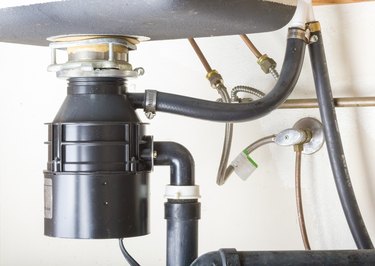
You notice water under your sink, and when you take a look at the garbage disposal with a flashlight, you notice that it's leaking. Upon closer inspection, you determine that water isn't coming from any of the pipes that connect to the garbage disposal, which leaves two possibilities. Either the flange connecting the garbage disposal to the sink is loose or worn or there's a hole in the garbage disposal.
You can use plumber's putty to repair the flange; in fact, that's what it's for. You can't use it as garbage disposal sealant to fix a hole, though, at least not permanently. That would be like trying to patch a hole in plumbing pipes with duct tape.
Video of the Day
Video of the Day
Using Plumber's Putty to Seal the Drain Flange
Although there are different formulations on the market, the basic recipe for plumber's putty is clay, linseed oil and perhaps some limestone, talc and fish oil. It's waterproof and remains flexible for a long time, although it will eventually dry out and become hard. "Hard" doesn't mean epoxy hard but rather break-apart-in-your-hands hard, much like sunbaked clay.
Plumbers need this stuff when installing drains. They put it underneath the drain flange, which is the part of the drain that overlaps the drain opening, and it makes a watertight seal when they tighten the nut to secure the drain to the sink. The plumber who installed the garbage disposal undoubtedly used plumber's putty, and the putty has probably dried out and cracked, which would be why the flange is leaking.
Plumber's putty isn't intended for pipe repairs. The garbage disposal isn't exactly a pipe, but for the purpose of stopping a leak, you can consider it as such. When it's on, it forces water under pressure through the drain, and plumber's putty can't stand up to pressurized water.
Using Plumber's Putty as a Garbage Disposal Sealant
If you see water leaking from the top of the garbage disposal, you can probably stop the leak by resetting the flange with new plumber's putty. Here's how to do it:
- Disconnect the power from the garbage disposal and disconnect all the pipes.
- Grasp the disposal, rotate it counterclockwise until it pops loose from the bracket holding it to the sink and remove it.
- Loosen the nuts and bolts holding the bracket to the sink and remove the mounting ring. This should release the flange from the top of the sink. Lift and remove it, and clean out all the old putty with a putty knife and rag.
- Take out a small amount of plumber's putty from the container and roll it into a rope. Wrap the putty around the underside of the flange, then reset the flange and mounting ring and tighten the nuts. Wipe off the excess putty that oozes out from under the flange.
- Put a stopper in the drain opening, fill the sink and check for leaks. If you don't find any, mount the garbage disposal and reconnect the pipes and the power.
Dealing with Other Leaks in a Garbage Disposal System
You may notice leaks coming from other parts of the garbage disposal, which usually means it's time to replace the disposal. You can sometimes stop leaks by disassembling the disposal and replacing worn seals inside the canister, but it probably isn't worth the effort.
If the garbage disposal is cracked or leaking, it's likely old and possibly rusted, which means it will leak again even if you invest the time and expense into fixing it. It's better to treat yourself to a new garbage disposal than it is to rely on a stopgap measure like plumber's putty, which is guaranteed to fail in short order.